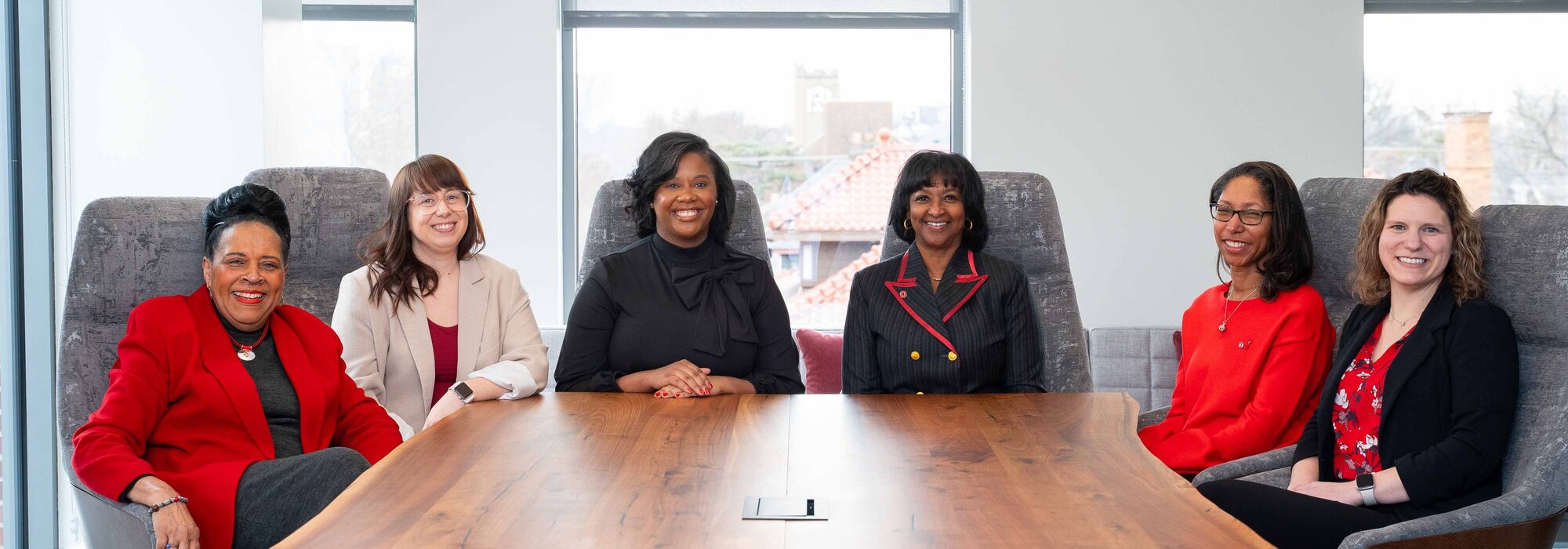
From Lab to Life
Pictured above from left: Barbara Jones Warren, Shannon Gillespie, Tara Crawford, Karen Patricia Williams, Holly Jones and McKenzie Jancsura
by Susan Neale
Eight nurse scientists from the Martha S. Pitzer Center for Women, Children and Youth at the College of Nursing discussed their research in a new series of videos hosted by college marketing strategist Tara Crawford, MA. Their conversations range from the circumstances that motivated them to become nurse scientists to candid insights about their personal lives, including techniques to de-stress and ways to balance work and family life.
This article highlights some of the lively conversations and insights our researchers shared. You can find the full series on our college’s YouTube channel.
As director of the Martha S. Pitzer Center for Women, Children and Youth, Karen Patricia Williams, PhD, leads and supports other faculty in their research. She also studies breast and cervical cancer prevention and control, and the intersection of cancer survivorship and cardiovascular disease. One of her career highlights was developing a cancer literacy assessment tool that is in use widely and has been translated into several languages.
“Our faculty are really energized, and they are committed,” she commented. “They don’t do research for research’s sake – they do research to make a difference.
They make a difference by designing varying types of interventions. Those interventions are practical, and they’re used in hospital and community settings, and so they are involved in the research continuum … from bench to bedside, and even to community or barrio and back again.”
“You can’t teach without knowing what’s going on in the clinical setting and you can’t exist in the clinical setting without trying to improve the education and what’s coming next.”
– Stephanie Hosley
Shannon Gillespie, PhD, RN, (’12 MS, ’15 PhD) was recently awarded a $3.8 million grant from the National Institutes of Health/National Institute of Nursing Research. Her research is focused on preventing mortality in mothers and infants. Designing research studies and analyzing data to create interventions is challenging, she said. “We need to know, does it work? Does it work for everyone? Is it equitable, is it scalable, is it sustainable? As you might imagine, there’s a lot of complexity to that.”
“Care of mom and baby after a complicated pregnancy is so important, and unfortunately often neglected,” Gillespie said. “What tends to happen with mom is that all the energy goes to baby and family, which is fantastic, but we also know that mom needs really good care and support during that year. A lot of deaths to moms are actually occurring not in the hospital, but after they go home – [from] day seven to day 365 … So that’s really our target.”
Barbara Jones Warren, PhD, APRN-CNS, FNAP, FAAN, (’90 MS, ’95 PhD) looks at stress and anxiety in Black women across the socioeconomic strata. She believes mental health and wellness are key. “Stress and anxiety mount for women,” she pointed out. “What happens with women is: they put themselves last. I think it’s important when we’re doing research to be in environments with a variety of women, to really see what’s happening.”
Warren has worked with diverse groups of women who all point to stress as the biggest culprit in managing mental health. She believes managing stress and anxiety with a variety of techniques can make a big difference.
“You can do things like a breathing technique [or] listening to music that you enjoy. You can do things like helping children to learn those same things so that they’re preparing themselves as they grow up.”
“Every morning, I get up and I spend about 45 minutes doing yoga, tai chi, some cardiovascular work, some stretching, some mindfulness … that’s my time.”
Holly Jones, PhD, APRN-CNP, RNFA, focuses on stress reduction and cardiovascular health among midlife African American women. As she developed materials and content for an intervention to mitigate stress and improve heart health, she found women from the community who would review material and provide feedback.
“I’ve leaned in a lot for community participatory work, and I’ve found that has been the best way to create an intervention for a population that you’re interested in, to make it more authentic and relevant for them,” Jones shared.
“As we started to develop the materials for the intervention and the content for the intervention, we had midlife women from the community look at the materials and provide us feedback, especially feedback regarding the cultural relevance. You know, ‘Is this even relevant to me? Does it even feel like it’s talking about anything that I’m worried about or concerned about?’ ”
Seeking participants and following-up with them was a multi-year process. Some of the women who offered feedback for materials were invited to help deliver the intervention. “It was for them, by them, completely involved from beginning to end.”
McKenzie Jancsura, PhD, RN, studies methods to recognize the source of pregnancy complications and ways to prevent pregnancy complications, especially preeclampsia. “We know that any woman that develops a pregnancy complication, in the years after pregnancy is much more likely to develop other cardiovascular disease. And not way in the distance – in two to five years after that pregnancy. A lot of that has been missed in our general care,” Jancsura said. “We assume, ‘Oh, you’re in your 20s or your 30s; you’re healthy,’ but that’s not necessarily the case.”
Her interest in studying these issues was inspired by her own mother. “When my mom was pregnant with my brother, my brother almost died. She was just so scared,” Jancsura said. “And I just thought, ‘We have to do something better than this.’ Pregnancy is the most normal biologic function to exist in the entire mammal world! … It shouldn’t be shrouded in secrecy and fear. It should be an exciting time for families.”

Marliese Nist, PhD, RNC-NIC, (’07, ’16 MS, ’19 PhD) wants to help infants in the NICU by studying the biological effects of stress exposure and ways to mitigate that stress.
Babies in the NICU experience a lot of stressors, Nist explained. “They experience things that we think of as benign, like a diaper change. A diaper change for a baby that small is a really stressful experience. These things that they experience over and over – how does that change their biology?”
While these infants don’t remember the experiences as memories the way older children and adults do, they remember trauma in their bodies, she said.
“The things that they experience in the NICU as preterm infants change the way their brains and their bodies function forever. And so, I’m looking at: What are those changes? How do we quantify those changes and predict what that baby will look like 10, 20, 30 years later?” The other arm of her research, she said, is looking for ways to buffer that stress.
Susie Breitenstein, PhD, RN, FAAN, started out as a child and adolescent psych nurse. After working with older children and their parents she became interested in opportunities for earlier intervention through parenting support.
“Parents are their children’s first teachers. They’re foundational to children’s social and emotional well-being and growth,” Breitenstein said. Her work with families starts with talking to parents and helping them identify their parenting values in order to connect with what they want from their children.
“One of the things we talk to parents about is, ‘In 10 years, how do you want your children to be?’ You can imagine that’s a universal list,” Breitenstein said. “Parents want their kids to be confident and feel loved and happy – all of those things. And so, we talk a lot about how what you do now is really foundational and important to help them get there.”
Stephanie Hosley, DNP, APRN-CNP, CNE, FNAP, (’95, ’98 MS, ’18 DNP) works as a nurse practitioner in a complex healthcare clinic that serves as primary care for children with neurodevelopmental disorders. Creating a treatment plan for these children involves more than just educating their families. “You have to listen first, listen to what their goals are for care, listen to what their needs are as a family and also what their challenges are as a family,” she said.
Hosley commented that some of her favorite moments teaching were with students who had difficulties along the way. “Sometimes our success stories are the ones that had a misstep, took some time off, came back and still finished ... they had resilience to come back and know that they still had something to contribute.”
“My experiences in the clinical setting are what prompted me to come back to teach,” she added. “You can’t teach without knowing what’s going on in the clinical setting and you can’t exist in the clinical setting without trying to improve the education and what’s coming next.”
In this Issue
- DNE: The Change Agents
- Clinician Well-Being Summit
- From Lab to Life
- Expanding Community Care
- Reaching out to Taiwan
- Buckeye Inspiration: David Hiatt
- Brain Health Fair
- Grants Roundup
- Student Life: Isabelle Meehan
- Connecting Young People in Crisis to Health and Hope
- Alumni in Action: Jeri Milstead
- Putting Our Heads Together for Brain Health

